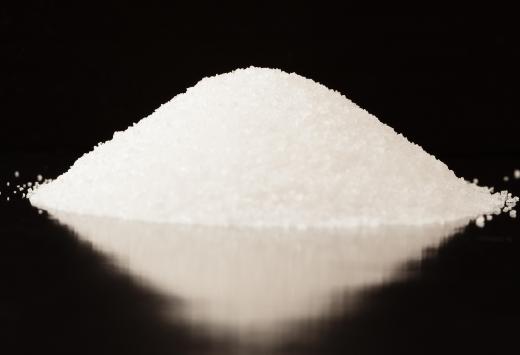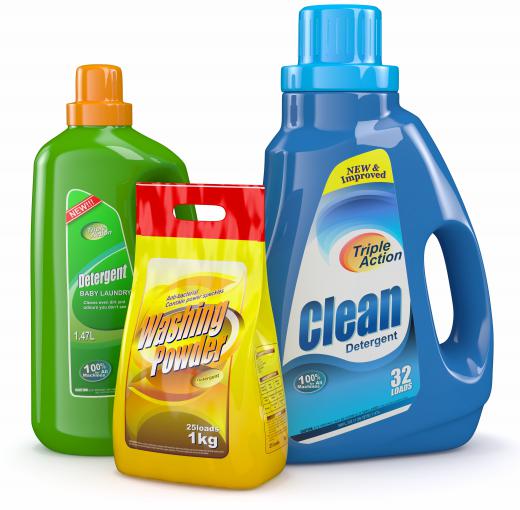What is Sodium Tripolyphosphate?
Sodium tripolyphosphate (STPP) is a chemical that has many uses in industry, ranging from an ingredient in cleaning products to a food preservative. Also known by alternate names like pentasodium salt or triphosphoric acid, the substance falls into the classification Generally Regarded As Safe (GRAS), which means that past use of the chemical has presented no risk to health. It can also be found in some paints and ceramic products, among other uses.
Chemistry

Structurally, STPP is made up of five sodium atoms, three phosphorous atoms, and ten oxygen atoms stuck together. It is commonly made by mixing monosodium phosphate and disodium phosphate to produce a white crystalline powder that has no smell and easily dissolves in water. These useful characteristics make it suitable for a variety of uses.
Cleaning Power

One of the common usages of STPP is as an ingredient in detergents and soaps. Most gel, liquid, tablet, and powder forms of both laundry and dishwasher detergent contain it. Its key function is that it allows surfactants, which are molecules that help dissolve surface dirt, to work at their full potential. The chemical can also soften hard water for easier foaming and cleaning, and it helps prevent dirt from sticking to the surfaces of the object being cleaned. Many general household cleaning products, including surface and toilet cleaners, contain STPP.
Food Applications

Sodium tripolyphosphate is also used to preserve foods such as red meats, poultry, and seafood, helping them to retain their tenderness and moisture during storage and transport. Pet food and animal feed can also be treated with it, serving the same general purpose as it does in human food. STPP also has been used to help preserve the quality of drinks such as milk and fruit juices.

Because sodium tripolyphosphate can improve the appearance of seafood like shrimp and scallops, there is some concern that unscrupulous salespeople may sell products that are not fresh to consumers who cannot see the signs that the items have started to go bad. Although it cannot be used specifically for this purpose, this chemical also holds in water, making the seafood heavier and therefore more expensive. Some food quality experts recommend asking a fishmonger or other salesperson for seafood that has not been treated with this chemical. Some stores will mark products that have not been exposed to STPP as "dry."
Other Uses

STPP's chemical characteristics are used in paint to keep the pigments evenly dispersed, and in ceramics to evenly distribute clay. Paper mills use it as an oil-resistant agent when coating paper, and it may also be used as a tanning agent for leather. Due to its cleaning action, it may also be an ingredient in toothpaste.
Safety Profile
Although sodium tripolyphosphate is generally regarded as safe, in very high quantities (such as ingesting large amounts of the pure chemical), it can be toxic. Chemical manufacturers make industrial grade and food grade sodium tripolyphosphate for the market; food grade contains the fewest impurities. There is some public concern about the presence of artificial preservatives such as STPP in food, but most current research suggests that it does not appear to cause health issues at the amounts normally ingested.
AS FEATURED ON:
AS FEATURED ON:















Discussion Comments
Huge migraine trigger for me. Trying to find out other things it’s in too, because it’s not just seafood. Just realized it’s in Ramen too.
Some reactions may be to MSG, This chemical has insidiously found its way back into many of the foods we eat today, under many different monikers.
I just found out stpp polyphosphate, whatever, all the same crap is the main ingredient of Vitamin D.
I have severe reactions to triphosphate in seafood. At least this is what I have isolated as the probable cause. I am 73 years old and this did not start until the mid 1990's.
I can eat fresh shrimp on the Gulf Coast with no problems. I can eat scallops in Connecticut with no problems. We travel to Italy every year and I never have any reaction to any food there except vongoli. The last episode was eating a crunchy shrimp roll in a Japanese restaurant. I have total bowel evacuation within one hour and am so sick from this that I sleep three or four hours when this happens. My kidneys seem to be affected also. I believe this may also be called E-451.
So sad how information can be so misunderstood and blown out of proportion. Even water can kill you in high enough doses.
In addition to STPP, I recently found the addition of Potassium Metabisulfite in shrimp. Sounds safe, doesn't it? This gives me terrible heart palpitations. I am allergic to sulfites so I suspect that this might be the culprit. Scary out there!
Sodium Tripolyposphate (STPP) is something to take seriously. Until last Friday evening, I paid little attention to it, but then, after baking some fresh previously frozen catfish fillets (purchased from a prominent grocery chain) and eating them, within several minutes I began having a serious allergic reaction with major swelling of face, eyes, nasal system, throat and could feel it affecting my lungs.
I had my wife immediately take me to hospital ER about three miles away, where I was treated for six hours for an acute allergic reaction. The ER and my doctor advised me always to call 911 as it is unpredictable how fast a reaction will proceed, and you can only live three minutes without oxygen!
Anyway, the following day I went to store fish market and insisted on seeing the supplier case label ingredients (USA farm raised) and there was Sodium Trepolyphosphate (STPP). Then I started a lot of research and came upon this site. Enough has been said about STPP.
Subsequentlym I have tested eating catfish, squid and lot of fried shrimp without STPP and I have not had any reactions! And no, I am not going to try fish with STPP!
The doctor said I was close to death. I hope this helps someone else.
If you're uncertain, as some people may react differently, try it with an open mind and be prepared to act. -- GG
Its interesting that folks think that just because some ingredient like STPP doesn't instantly kill us and that the FDA (Federal Death Administration ) says its GRAS, that it is. I have zero faith in the USDA and FDA. FDA employees have bought out by people like Monsanto, who now work for them. The bottom line to all this is greed. They could care less about the people they're harming in the long run, so long as they make their precious money.
I have always been one of the people who called out the "chicken littles" who overreact to additives in food.
Well tonight, I started eating shrimp from a bag of Aqua Star frozen cooked shrimp. I was eating them with my fingers since I made shrimp cocktail. Apparently, I rubbed my eye with my fingers and immediately my eye started to burn. It became so bad, that I went to the bathroom to get a wet cloth and noticed the skin all around my eye was bright red and was starting to swell. Within about 10 minutes, my eye was swollen shut.
I did everything. I irrigated my eye for almost 20 minutes, took benedryl. Now, seven hours later, I am just barely able to open my eye, the glands in my neck are swollen and I am having difficulty swallowing. I didn't go to the ER because I read online about STPP being a severe eye irritant, and nothing can really be done aside from what I was already doing. The amount of swelling is unbelievable, even now.
I am suspecting that the level of STPP is very high in this product. I assume there is no regulation. I've taken pictures and plan to contact the FDA, like that will do any good, but this needs to be reported. If a tiny bit on my fingertips could cause such a severe reaction, something is wrong. There should be warnings and there should be regulation ensuring against extremely high levels of this.
STPP is not a problem for me, but, boy did my dishes get filthy when they removed it from the detergent. My guess is that chlorine in our water strips out the natural flora in our systems, but, rarely a person dies from bad water. It is a good trade, in my humble opinion. I lost a lot of food sensitivities by taking really cheap probiotics with enzymes from the Mart store.
I recently have been diagnosed as having Celiac's Disease. I have been extremely careful with what I eat and how it is made. I have become sick a couple times after eating frozen salmon, scallops, shrimp, and steak. Everything points to this chemical! I have violent vomiting and diarrhea. Is there a specific test for this chemical? I am all for this being banned; the things I have been reading are extremely unsettling!
Aside from a few posts on this site, the breadth of this thread is terrifying!
First, to the one whose wife suffered angioedema and tachycardia from her Banquet pot pie, that's from the cardiac effects of the excessive salt intake, not from the STPP! Second, not all shellfish is toxic. There are those with shellfish allergies that have nothing to do with the water content that the fish are raised in. It pertains to the shells themselves.
This product is used to preserve the food we eat because the average household goes out and buys prepared food at an astoundingly high level, instead of preparing it ourselves. We expect to have fresh food in our stores for low prices, yet without these products those same people would not buy any of the stores food products out of ignorance. (For example, the mayo was out at room temp for three hours? throw it out and buy another one! Instead of the mayo is fine, no separation, no smell, no color change, no problem.) These people complain that others have to take better care of our environment and yet, are willing to throw away good food products out of ignorance and fear that wastes our natural resources.
The companies have to put chemicals to preserve and maintain the freshness of the product, rightfully so, and do so within the limits allowed. The alternative is to throw away perfectly good food out of aesthetics and destroy even more of the food reserves we have available to us!
To the Kraft Macaroni and cheese post - an alternative, is to melt some cheddar with milk and butter in a pot under low heat, and at the same time boil your families favorite pasta in a separate pot. Drain the water from the pasta, combine in the cheese mixture and serve. Prep time is 20 minutes. You can have the STPP shaker on the table if you choose.
@anon285189: You are wrong. STPP is not a preservative. It is used to improve the appearance of frozen food items. I don't think it's that toxic, but because it has the effect of holding water, it is frequently used to increase the weight of frozen fish. I have bought frozen fish at Wal-Mart that had so much extra water in it, it went to mush when I cooked it. I am guessing that is the STPP. Now I press it between paper towels before cooking.
To the one poster who said they got a migraine from eating shrimp with STPP: how do you know it was in fact the STPP that gave you the migraine? Shrimp is a shellfish and all shellfish is toxic.
If you are going to eat anything from out of the oceans or rivers or lakes, the fish that you eat must have scales and fins. Some of you may realize that this is one of the kosher laws. Fish with scales and fins have a digestive system that doesn't allow poisons in the water to be absorbed into the flesh. Remember, fish actually swim in their own excretions. All living animals in the seas, lakes, rivers, and streams deposit their feces and bodily excretions into the same water they are swimming in. When you think about that for a moment, it becomes a little sickening.
Fish that have scales and fins, like flounder, cod, haddock, mackerel, and salmon, do not absorb the toxins in the water. Other animals of the sea that have fins but no scales, such as catfish, are generally bottom feeders and scavengers, and have digestive systems that absorb the toxins from the water.
Other animals in the sea such as clams, shrimp, mussels, squid, lobster, and crab have neither scales nor fins and are highly toxic. They absorb all the poisons from the water.
The problem: FDA does not test imported seafood for STPP levels.
This STPP is also "hidden salt" in our diets. Most
restaurant and food labels have incorrect sodium levels listed because of STPP. So people buying salmon for health reasons. We need to be aware.
How can we get our government to remove STPP? I am allergic to it as well.
"If you can't pronounce it you probably shouldn't ingest it."
So-called rules of thumb break down at the level of description on a food label. Every organic, ripe strawberry (straight from the bush) contains the following naturally occurring chemicals, some of which could be hazardous if 'ingested directly', i.e., a spoonful of the pure stuff: Amyl acetate, amyl butyrate, amyl valerate, anethol, anisyl formate, benzyl acetate, benzyl isobutyrate, butyric acid, cinnamyl isobutyrate, cinnamyl valerate,
diacetyl, dipropyl ketone, ethyl acetate, ethyl amyl ketone, ethyl butyrate, ethyl cinnamate, ethyl heptanoate, ethyl heptylate, ethyl lactate, ethyl methylphenylglycidate, ethyl nitrate, ethyl propionate,
ethyl valerate, heliotropin, hydroxyphenyl-2-butanone,
alpha-ionone, isobutyl anthranilate, isobutyl butyrate, 4-methylacetophenone, methyl anthranilate, methyl benzoate, methyl cinnamate, methyl heptine carbonate, methyl naphthyl ketone, methyl salicylate, phenethyl alcohol and gamma-undecalactone.
For the people who don’t understand why STPP is used to preserve meats, it’s very simple. The meat would spoil or become inedible, even frozen, without it.
Our freezers are not magical boxes that stop the flow of time. Frozen meats (especially delicate meats like shellfish) quickly become dehydrated and freezer burned, even if you seal them in airtight plastic wrap.
Also, freezing causes ice crystals to form within the cells of the meat, causing them damage. Once thawed, this damage causes a lot of the moisture and nutrients (and the best taste with it) to be lost. This is called “drip loss,” and STPP goes a long way towards preventing that.
Without STPP, almost every frozen meat product would become chewy and disgusting after a few weeks in the freezer, and lose a lot of their nutritional value.
It’s true though, like every other chemical compound, STPP ingested in large quantities is not healthy. It’s a chemical base, hence the use in detergents and water treatment. The amount used in food processing is supposed to be very low (a tenth of a percent or lower).
Did you know ingesting too much salt can kill you? That’s why drinking seawater is bad. Yet we put salt in/on almost all of our food. It’s even in your can of soda. Did you know drinking too much water can put you in the hospital, and even kill you? It’s called water intoxication. Look it up. That doesn’t make it poison.
If STPP is generally known to be safe, then why is it not intended to be ingested or directly inhaled by either human beings or by animals?
After reading all the above posts, I am wondering why people are still buying such products which has STPP, and I am also thinking why isn't anyone banning these products that contain this deadly chemical?
I am doing some research into the effect on IBS of ingestion of non-food residual toxins from household cleaning products. I'd particularly like to hear from anon159874 who wrote about sulfa drugs and STPP.
The better domestic shrimp processors are getting away from this and using a natural salt product called VFish,which is a combination of mineral-rich sea salt with proprietary plant extract formulations.
VFish is supposed to enable easier deboning of fish for processors by ensuring a firmer flesh structure due to its water-binding capacities.
It binds water within the cells, as opposed to phosphates which do so between cells.
All shrimps need to be frozen right after being caught on the boat so they do not go bad. Since they go bad very fast and turn black on the edges of their shell, there would be no time to bring it even to shore. Shrimp boats stay out for fishing for weeks on time and in that time the shrimp have to be frozen.(even the "fresh" shrimp in store were once frozen- all of them!) The way they get frozen is to throw them into a brine solution right away to freeze them. But the solution needs to stay liquid so you can throw the shrimp in and then take the frozen ones out after a short time. This substance helps to accomplish that. Otherwise it would take longer and the water would be a frozen block with shrimps frozen inside of the block and not individual frozen shrimps which can be processed.
So basically, it helps freeze them faster, keeps them frozen and preserved while handling and keeps them from turning black. If you buy shrimp, peel the shell and wash them well! --wife of a fisherman
Has anyone checked out sodium nitrates or nitrites? These chemicals are in bacon, sausage, ham, and most all processed and cured meats. They are killing us!
The problem is when the fish comes from the China or Thailand, we donot know "the dose". It could be saturated with STPP. Who is checking it? I have a severe migraine right now from an overdose of STPP laden shrimp.
This is also a way to cheat the consumer as makes the fish or shrimp absorb water and you end up paying for water weight. It can also make a bad quality product appear to be fine.
People really do not read all the information given, do they? STPP is safe when mixed in foods and is in small quantities. It is not meant for you to eat it or snort it but to help manufacturers in processing a product.
Salt is also used to help whiten clothes in the wash so don't eat any more of that and you put it directly on your food and in your mouth. You will die more from all the fats in foods than from chemicals, and just so you know, in case no one ever told you, but you are going to die some day. You will not live forever and if you don't believe me, go to the cemetery and see if it's empty.
Look at all the people going off the deep end. Sheesh! A little knowledge in the wrong hands is a dangerous thing. Next up, Dr. Mercola will have a page up about this and will be selling gullible people some kind of seaweed detox remedy to rid the body of it.
Did you know that this is also in Kraft Macaroni and Cheese? Our kids eat this stuff!
There are other things you need to be aware of, like Triclosan. It's a toxic pesticide and effects the human thyroid gland, and possibly other internal organs. Triclosan is found in antibacterial soap and colgate toothpaste for sensitive teeth.
Let's see. Government took out the sulfa drugs as preservatives. Sulfa drugs, like BHA and BHT stopped cholera, dysentery, IBS, etc. Now they put in STPP! Ever hear of spontaneous human combustion? It is caused by the uncontrolled cascading breakdown of phosphate in the body.
Why would the FDA allow STPP in foods? Causes digestive problems, blood problems, and whatever else than can be caused by chemicals that burn the skin! Insanity!
Caffeine is really 1,3,7-trimethylxanthine. Bet you can't pronounce that while drinking your tea and coffee.
The MSDS states "do not ingest."
Get over your chemophobia. You are made of chemicals for heaven's sake.
My wife had a Banquet turkey pot pie. She developed a red face, itching, fast heart rate, and noticed an extremely strong salty taste. Strange.
I bought wild caught salmon from Wal-Mart. It has STPP to retain moisture. This stuff is also used to make detergents for your clothes and dishes because it is a cleaning chemical. Then they want us to eat it too. What's up with that?
I ate some Wolf brand chili noticed afterward a trip to the bathroom and a head ache like migraines my stomach don't feel quite settle yet a few hours later I looked on the can to read the ingredients to learn of the Sodium Tripolyphosphate no more I will do from scratch with the chili Please pass this information along. This is not good.
This is all new to me! Last night I ate some basa fillets from super store, and this morning I awoke with large hive-like welts all over my neck, ears, and upper body! Checking the label,
I read basa, salt, sodium tripolyphosphate. I checked to see if this could be the culprit, and am finding many sites where people report a reaction to this chemical. why is this not included in the labeling? I am presently taking an antihistamine, but the rash is still spreading!
I'm allergic to it. I get huge hives whenever I eat it.
Also, STPP is a registered pesticide.
STPP sure ruins shrimp taste and texture and is not at all necessary. Face it, we are systematically being made sick by the big food corporations that control the FDA and the USDA. Ya think?
To those complaining of toxicity, remember it is the dose that makes a poison. Virtually everything is toxic at high enough doses, including DHMO. But at safe levels these chemicals save lives.
Because advertisers and corporations run the world and prey on uneducated consumers.
I found it in AquaStar Cooked Prawns, product of Thailand, sold as frozen food at The Real Canadian Superstore. Ingredients: prawns, salt, sodium tripolyphosphate (for moisture retention). Sounds innocuous. Most shrimp in the supermarkets are full of toxins nowadays. We're killing ourselves.
Yeah, that DHMO, I can't believe they allow that stuff on the market at all! Someone aspirated only a tiny amount in my office just yesterday and they had to spend 10 minutes in the bathroom just to regain their composure- I never allow the stuff in the house.
what is the alternative to STPP in soap making?
Some of these comments only make me realize how easy it is for people to take information out of context and then panic without reason. Many chemicals serve both food-related and industrial purposes. Sodium Tripolyphosphate is listed as an FDA direct food additive (21 CFR 173.310) and is GRAS, meaning generally recognized as safe.
Another one to really worry about would be Dihydrogen Monoxide (DHMO)! Seriously. Look it up. You and your children have unwittingly been exposed to this powerful chemical for years! My goodness, we are just surrounded by these awful, awful chemicals, aren't we?
Many preservatives have never been tested for the effects on humans. STPP is a suspected neurotoxin from what little research has been conducted. Just passing along what I know
I am appalled by the definition of this STPP. I was reading the ingredients in Gorton's Fish Sticks, before I fed them to my eight year old son, and found this ingredient.
I have learned over the years, if you can't pronounce it you probably shouldn't ingest it, so i looked up the step. I cannot believe that it says "not intended to be ingested or indirectly inhaled by human beings or animals".
Why the heck would it be in the food we feed our children? I would love an explanation.
It's the dose that makes the poison. In our
modern chemical training we have forgotten that. Chlorine, for example, can be used to gas soldiers or to kill bacteria in your drinking water.
STPP can be used quite safely in the right dose in the right place. You have to read all the instructions, not just pick out hazard statements out-of-context.
I read this article, and am as aghast as you are! My roommate bought wild caught salmon that was prepackaged and it has this junk in it! The more I read about STPP, the more ticked off I become. All I taste is soap; I can't even tell I'm eating fish.
"STPP is not intended to be ingested or directly inhaled either by human beings or by animals." Then why is it in our food?
Post your comments